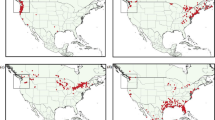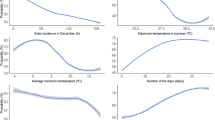Abstract
Understanding the potential spread of invasive species is essential for land managers to prevent their establishment and restore impacted habitat. Habitat suitability modeling provides a tool for researchers and managers to understand the potential extent of invasive species spread. Our goal was to use habitat suitability modeling to map potential habitat of the riparian plant invader, Russian olive (Elaeagnus angustifolia). Russian olive has invaded riparian habitat across North America and is continuing to expand its range. We compiled 11 disparate datasets for Russian olive presence locations (n = 1,051 points and 139 polygons) in the western US and used Maximum entropy (Maxent) modeling to develop two habitat suitability maps for Russian olive in the western United States: one with coarse-scale water data and one with fine-scale water data. Our models were able to accurately predict current suitable Russian olive habitat (Coarse model: training AUC = 0.938, test AUC = 0.907; Fine model: training AUC = 0.923, test AUC = 0.885). Distance to water was the most important predictor for Russian olive presence in our coarse-scale water model, but it was only the fifth most important variable in the fine-scale model, suggesting that when water bodies are considered on a fine scale, Russian olive does not necessarily rely on water. Our model predicted that Russian olive has suitable habitat further west from its current distribution, expanding into the west coast and central North America. Our methodology proves useful for identifying potential future areas of invasion. Model results may be influenced by locations of cultivated individuals and sampling bias. Further study is needed to examine the potential for Russian olive to invade beyond its current range. Habitat suitability modeling provides an essential tool for enhancing our understanding of invasive species spread.



Similar content being viewed by others
References
Araujo MB, Luoto M (2007) The importance of biotic interactions for modelling species distributions under climate change. Glob Ecol Biogeogr 16:743–753
Billerbeck R (2003) Colorado state parks weed data. Colorado State Parks
Bradley BA, Oppenheimer M and Wilcove DS (2009) Climate change and plant invasions: restoration opportunities ahead? Global Change Biology
Bradley BA, Blumenthal DM, Wilcove DS and Ziska LH (2010) Predicting plant invasions in an era of global change. Tree (in press)
Cooper DJ, Merritt DM, Andersen DC, Chimner RA (1999) Factors controlling the establishment of Fremont cottonwood seedlings on the upper Green River, USA. Reg Rivers Res Manage 15:419–440
Crosier CS (2004) Synergistic methods to generate predictive models at large spatial extents and fine resolution, Graduate Degree Program in Ecology. Colorado State University, Fort Collins, p 119
DAYMET (2006) Climatological summaries for the conterminous United States, 1980–1997. Daily surface weather and climatological summaries (DAYMET; http://www.daymet.org)
DeCant JP (2008) Russian Olive, Elaeagnus Angustifolia, alters patterns in soil nitrogen pools along The Rio Grande River, New Mexico, USA. Wetlands 28:896–904
Evangelista PH, Kumar S, Stohlgren TJ, Jarnevich CS, Crall AW, Norman JB, Barnett DT (2008) Modelling invasion for a habitat generalist and a specialist plant species. Divers Distrib 14:808–817
Freeman EA, Moisen GG (2008) A comparison of the performance of threshold criteria for binary classification in terms of predicted prevalence and kappa. Ecol Modell 217:48–58
Friedman JM, Auble GT, Shafroth PB, Scott ML, Merigliano MF, Preehling MD, Griffin EK (2005) Dominance of non-native riparian trees in western USA. Biol Invasions 7:747–751
Gochis DJ, Brito-Castillo L, Shuttleworth WJ (2006) Hydroclimatology of the North American Monsoon region in northwest Mexico. J Hydrol 316:53–70
Heikkinen RK, Luoto M, Araujo MB, Thuiller W, Sykes MT (2006) Methods and uncertainties in bioclimatic envelope modelling under climate change. Prog Phys Geogr 30:751–777
Hijmans RJ (2006) MkBCvars.AML version 2.3. http://worldclim.org/bioclim.htm
Hirzel AH, Le Lay G, Helfer V, Randin C, Guisan A (2006) Evaluating the ability of habitat suitability models to predict species presences. Ecol Modell 199:142–152
Hood WG, Naiman RJ (2000) Vulnerability of riparian zones to invasion by exotic vascular plants. Plant Ecol 148:105–114
HR2720 (2006) Salt Cedar and Russian Olive Control Demonstration Act. United States Congress
Jarnevich CS, Stohlgren TJ, Barnett D, Kartesz J (2006) Filling in the gaps: modelling native species richness and invasions using spatially incomplete data. Divers Distrib 12:511–520
Jimenez-Valverde A, Lobo JM (2007) Threshold criteria for conversion of probability of species presence to either-or presence-absence. Acta Oecologica Int J Ecol 31:361–369
Katz GL, Shafroth PB (2003) Biology, ecology and management of Elaeagnus angustifolia L. (Russian olive) in western North America. Wetlands 23:763–777
Katz GL, Friedman JM, Beatty SW (2005) Delayed effects of flood control on a flood-dependent riparian forest. Ecol Appl 15:1019–1035
Lesica P, Miles S (1999) Russian olive invasion into cottonwood forests along a regulated river in northcentral Montana. Canadian Journal of Botany—Revue Canadienne De Botanique 77:1077–1083
Liu CR, Berry PM, Dawson TP, Pearson RG (2005) Selecting thresholds of occurrence in the prediction of species distributions. Ecography 28:385–393
Naiman RJ, Decamps H, Pollock M (1993) The role of Riparian corridors in maintaining regional biodiversity. Ecol Appl 3:209–212
NPS (2003) Data and Information: Data Clearinghouse. National Park Service
Phillips SJ (2008) Transferability, sample selection bias and background data in presence-only modelling: a response to Peterson et al. (2007). Ecography 31:272–278
Phillips SJ, Anderson RP, Schapire RE (2006) Maximum entropy modeling of species geographic distributions. Ecol Modell 190:231–259
Phillips SJ, Dudik M, Elith J, Graham CH, Lehmann A, Leathwick J, Ferrier S (2009) Sample selection bias and presence-only distribution models: implications for background and pseudo-absence data. Ecol Appl 19:181–197
Quinn JF, Thorne J (2007) California invasive plant data
Reynolds LV, Cooper DJ (2010) Environmental tolerance of an invasive riparian tree and its potential for continued spread in the Southwestern US. J Veg Sci 1–11. doi:10.1111/j.1654-1103.2010.01179.x
Richard SH, White P (2001) Horticulture as a pathway of invasive plant introductions in the United States. Bioscience 51:103–113
Richardson DM, Holmes PM, Esler KJ, Galatowitsch SM, Stromberg JC, Kirkman SP, Pysek P, Hobbs RJ (2007) Riparian vegetation: degradation, alien plant invasions, and restoration prospects. Divers Distrib 13:126–139
Sabo JL, Sponseller R, Dixon M, Gade K, Harms T, Heffernan J, Jani A, Katz G, Soykan C, Watts J, Welter A (2005) Riparian zones increase regional species richness by harboring different, not more, species. Ecology 86:56–62
Shafroth PB, Auble GT, Scott ML (1995) Germination and establishment of the native plains cottonwood (Populus-Deltoides Marshall Subsp Monilifera) and the exotic Russian-olive (Elaeagnus-Angustifolia L). Conserv Biol 9:1169–1175
Shafroth PB, Beauchamp VB, Briggs MK, Lair K, Scott ML, Sher AA (2008) Planning riparian restoration in the context of Tamarix control in western North America. Restor Ecol 16:97–112
Stohlgren TJ, Bull KA, Otsuki Y, Villa CA, Lee M (1998) Riparian zones as havens for exotic plant species in the central grasslands. Plant Ecol 138:113–125
Stohlgren TJ, Schell LD, Bull KA, Otsuki Y, Newman G, Bashkin M, Son Y, Binkley D, Chong GW, Kalkhan MA (1999) Exotic plant species invade hot spots of native plant diversity. Ecol Monogr 69:25–46
Strayer DL, Eviner VT, Jeschke JM, Pace ML (2006) Understanding the long-term effects of species invasions. Trends Ecol Evol 21:645
Swets JA (1988) Measuring the accuracy of diagnostic systems. Science 240:1285–1293
Thomas K, Guertin P (2007) Southwest non-native invasive plant database (SWEMP07). U.S. Geological Survey, Southwest Biological Science Center (USGS-SBSC)
USDA (2009) The PLANTS Database, National Plant Data Center, NRCS on
Utah BLM (2006) Utah noxious weeds. Bureau of Land Management
Vieira J (2003) Royal Gorge area weed mapping data. Bureau of Land Management
Wilson JRU, Richardson DM, Rouget M, Proches S, Amis MA, Henderson L, Thuiller W (2007) Residence time and potential range: crucial considerations in modelling plant invasions. Divers Distrib 13:11–22
Acknowledgments
We would like to thank the many people who donated datasets to our research efforts especially the Southwest Exotic Plant Mapping Program, the Utah BLM office, the Colorado Department of Transportation, Pat Shafroth and Jonathan Freidman. We thank the National Park Service, Colorado State University and the US Geological Survey Fort Collins Science Center for logistical support. We thank Jonathan Friedman and Tom Stohlgren for providing comments on an earlier version of our manuscript. Any use of trade, product, or firm names is for descriptive purposes only and does not imply endorsement by the U.S. Government. Two anonymous peer reviewers provided additional comments. To all we are grateful.
Author information
Authors and Affiliations
Corresponding author
Rights and permissions
About this article
Cite this article
Jarnevich, C.S., Reynolds, L.V. Challenges of predicting the potential distribution of a slow-spreading invader: a habitat suitability map for an invasive riparian tree. Biol Invasions 13, 153–163 (2011). https://doi.org/10.1007/s10530-010-9798-4
Received:
Accepted:
Published:
Issue Date:
DOI: https://doi.org/10.1007/s10530-010-9798-4




